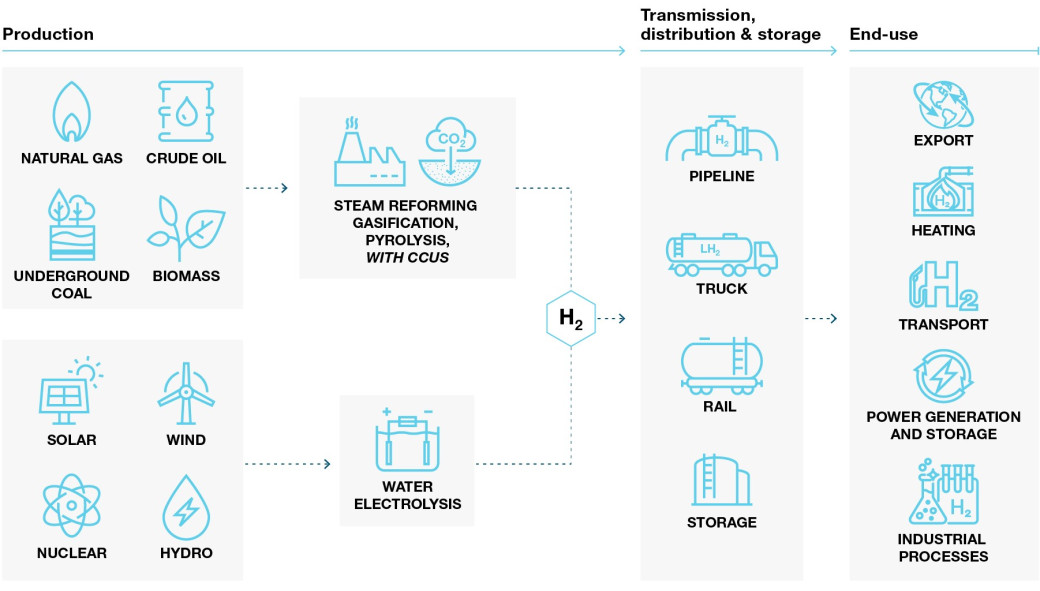Government mail service may be affected by the Canada Post labour disruption. Learn about how critical government mail will be handled.
As a world leader in hydrogen production and Carbon Capture, Utilization, and Storage (CCUS) technology, Alberta is in a position to rapidly advance a clean hydrogen economy.

Hydrogen produces no carbon emissions when combusted directly in a fuel cell, and it has the potential to reduce emissions across many sectors in Alberta’s economy. Large quantities of clean hydrogen can be produced for use in Alberta and in countries around the world.
Hydrogen production
Hydrogen can be produced from a variety of sources, such as fossil fuels, biomass, and water. Clean hydrogen refers to hydrogen produced with minimal emissions.
Natural gas-based hydrogen production
Steam methane reforming
For more than 50 years, Alberta’s industrial processes have used natural gas-based steam methane reforming to produce hydrogen for industrial processes, such as chemical production, oil refining and upgrading.
Autothermal reforming
Autothermal reforming of natural gas is another technology that is being proposed for new large-scale hydrogen production in Alberta. This technology allows for higher emissions reductions from hydrogen production.
Both steam methane and autothermal reforming hydrogen production can be paired with CCUS to reduce emissions, resulting in clean hydrogen energy.
Renewable-based hydrogen production
Hydrogen can be produced using renewable electricity in a process called electrolysis, where water molecules are split into hydrogen and oxygen gas.
In Alberta, wind-powered hydrogen produced by electrolysis presents significant opportunities to produce clean hydrogen.
Further research and large-scale deployment is needed to improve efficiency for electrolysis technologies to make them cost-competitive and to match the scale currently available with natural gas-based hydrogen production methods.
Other hydrogen production processes
Other processes generating significant interest include:
- methane pyrolysis
- biomass conversion
- emerging in-situ methods
Most of these gas pyrolysis technologies are still in the early stage of development. Early-stage developers in Canada include Ekona, Aurora and the University of British Columbia, each demonstrating different forms of the natural gas pyrolysis technology and developing demonstration plants in Alberta. Australia-based Hazer Group has partnered with FortisBC to develop a pilot plant in British Columbia.
Transport and storage
Hydrogen is an energy carrier with great potential to store and distribute large amounts of energy.
Hydrogen distribution and transport
Hydrogen is typically transported as a compressed gas or cooled liquid by truck, or transmitted by pipeline.
Alberta has over 100 km of pipelines in the province that can transport pure hydrogen to industrial users, where hydrogen is used as a part of industrial applications. However, there currently are no large, high pressure pipelines in Canada that deliver pure hydrogen to major demand centres.
Ammonia and methanol are other chemical compounds that can effectively carry hydrogen, and can be converted back to hydrogen gas at their destination. This method of moving hydrogen is a major contributor to Alberta’s hydrogen economy today. Both substances can efficiently transport hydrogen over long distances by pipeline and rail, including to overseas markets.
Other hydrogen carriers – such as liquid organic hydrogen carriers, which are compounds that absorb and release hydrogen – can store hydrogen and are promising opportunities for Alberta to transport hydrogen to international markets.
Hydrogen storage
Hydrogen in gas or liquid form requires storage. Large volumes of hydrogen can be stored underground for later use, similar to how natural gas is stored in underground salt caverns.
Hydrogen production facilities typically have short-term hydrogen storage on site, where hydrogen is stored as compressed gas or as an extremely cold liquid in tanks.
Large volumes of hydrogen can also be compressed and stored in underground salt caverns or depleted hydrocarbon reservoirs. The stored hydrogen can be used later to balance variations in energy intermittent renewable energy production and seasonal heat demand, or for other end uses such as chemical feedstock or transportation fuel.
End uses of hydrogen
Hydrogen can be used for residential and commercial gas utility purposes, fuel cell electric vehicles and industrial processes. It can also be used as a feedstock for manufacturing other products, power generation and storage, and export markets.
Ammonia and methanol are hydrogen carriers that are major contributors to Alberta’s hydrogen economy today. In addition to their role as a way to move hydrogen in a chemical format, these chemical products have many current uses including:
- Ammonia:
- fertilizer for agriculture
- manufacture synthetic fibres or pharmaceuticals
- mining and metallurgic sectors
- industrial refrigeration
- power generation
- Methanol:
- producing plastics, foams, resins, and paints
- cleaning products
- formaldehyde for building products
- pharmaceutical products
- fuel blending as a clean-burning fuel for turbines and internal combustion engines
Contact
Connect with the Natural Gas Strategy and Engagement Branch:
Hours: 8:15 am to 4:30 pm (open Monday to Friday, closed statutory holidays)
Email: [email protected]
Mailing Address:
Alberta Energy and Minerals
Natural Gas Strategy and Engagement Branch
6th Floor, North Petroleum Plaza
9945 108 Street*
Edmonton, Alberta T5K 2G6
* Couriers, please report to the 2nd floor.